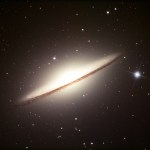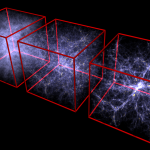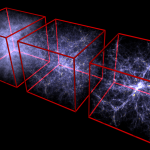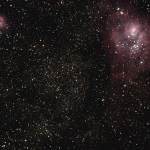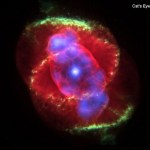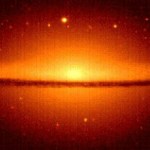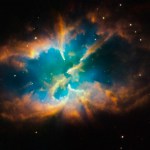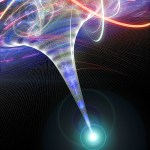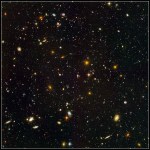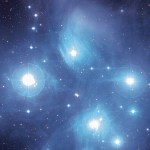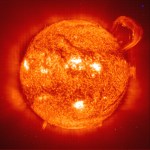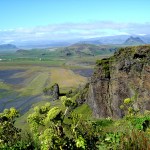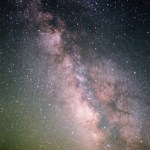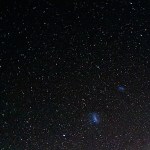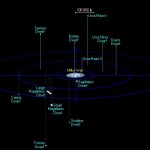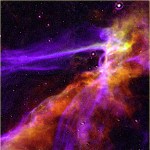Stars
"I may be an old lion, but if someone puts his hand in my mouth, I can still bite it off." -Wilhelm Steinitz
When you look at a typical galaxy, you usually find a disk, a bulge, and a few dots diffusely strewn about the exterior.
Like an old lion, these dots have been around for a very long time: often for longer than the galactic disk itself! Just what are these things? Well, we can learn a little more if we look in the X-ray (with Chandra) and the infrared (with Spitzer), in addition to a visible light image (from Hubble). Let's take a look at a composite:
Just what are these dots that…
Perhaps in time the so-called Dark Ages will be thought of as including our own.
-Georg Lichtenberg
We've been going through the history of the Universe -- from inflation to the present day -- and you can read parts 1, 2, 3, 4, 5, 6, 7, 8, and 9 here. The last thing that happened was we had a Universe filled with neutral atoms -- mostly hydrogen with some helium and a negligible amount of everything else -- that had begun to collapse under its own gravity.
When a few regions of space got dense enough, about 50 million years into the story, we made the first stars!
But there's a problem when…
People are like stained-glass windows. They sparkle and shine when the sun is out, but when the darkness sets in their true beauty is revealed only if there is light from within. -Elisabeth Kübler-Ross
Welcome back to The Greatest Story Ever Told, where we're covering the natural history of the Universe from before the Big Bang to the present day. You can catch up on the first eight parts here, going forward from Inflation in part 1 to parts 2, 3, 4, 5, 6, 7, and reaching the formation of the first neutral atoms in part 8. But during all of this time, gravity has been working its magic.
In…
tags: nature, stars, astronony, new discovery, amateur astronomer, citizen scientist, supernova, supernova 2008ha , stellar explosion, Caroline Moore, streaming video
There is no age restriction on the chance to make a significant contribution to our understanding of the universe. Caroline Moore, a 14-year-old from Warwick, NY, has made such a mark on astronomy with the discovery of Supernova 2008ha. Not only is she the youngest person to discover a supernova, but this particular supernova has been identified as a different type of stellar explosion.
To borrow one of her favorite words,…
Better to light a candle than to curse the darkness. -Chinese Proverb
Every once in a while, we'll look out into the sky with a telescope, and see some spectacular glowing gas.
These nebulae typically come about from dead or dying stars, and are some of the most spectacular sight in the sky for astronomers, from amateur to professional.
But in the 1940s, an astronomer named Bart Bok observed these little dark "defects" in a few of these nebulae. It looked like something dark was simply sucking in all of the light around it, and refused to let any out.
In fact, looking even with modern…
tags: Galactic Center of Milky Way Rises over Texas Star Party, astronomy, science, stars, Milky Way, streaming video
This fascinating video is a time lapse video of night sky as it passes over the 2009 Texas Star Party in Fort Davis, Texas. In this video, you will see the bright galactic core of the Milky Way crossing the Texas sky. Images taken with 15mm fisheye lens.
Before you were conceived I wanted you
Before you were born I loved you
Before you were here an hour I would die for you
This is the miracle of love. -Maureen Hawkins
But I'm not talking about human children, I'm talking about the children of the stars. Stars burn their fuel until they no longer can, and then die in one of two impressive ways, depending on how massive they are. If a star is up to around four times as massive as our Sun, it dies by collapsing down to a white dwarf and blowing off its outer layers into a planetary nebula.
On the other hand, if your star is very massive -- like…
Have you been keeping up with The Boston Globe's Hubble Advent Calendar? Today's picture is totally worth talking about, and gives me a chance to tell you about these little guys that just hang-on to our galaxy: globular clusters. When you look out at a galaxy -- pretty much any galaxy -- you'll find these tiny clumps of light surrounding it.
These clumps are actually amazing, dense collections of stars! If you look out at the nearest star to us, it's Proxima Centauri, located just over four light years away. That means if you drew a sphere centered on the Earth four light years in radius,…
At the last dim horizon, we search among ghostly errors of observations for landmarks that are scarcely more substantial. The search will continue. The urge is older than history. It is not satisfied and it will not be oppressed. -Edwin Hubble
Hubble didn't need a thousand words to describe how beautiful and wondrous the Universe is, and the Hubble Space Telescope can -- perhaps -- say even more in just a simple picture.
Well, the Boston Globe, starting today, has a full 25-day advent calendar of Hubble pictures, which it reveals one of per day. Today's? (And click to enlarge.)
Planetary…
All that matters, in the real world, is that something is both massive and compact enough so that, within a certain radius, light cannot escape from it. That is the astrophysical definition of a black hole. -me
We've been talking about black holes a lot recently, and with good reason. They're fun to think about. These objects that collect matter, energy, light, and anything else that dares to cross its event horizon. It's only natural to ask what might lie beneath that dark area that no light ever escapes from.
Image credit: mondolithic.com.
In 1916, everyone assumed that whatever happened…
The farther backwards you can look, the farther forwards you are likely to see. -- Winston Churchill
Sometimes, we point our most powerful telescopes at the sky, peering as deeply as we possibly can, hoping to shed some light on what the Universe was like oh-so-long ago, as close to the big bang as we can. The Hubble Space Telescope can get us distant galaxies as they were just a few billion years after the big bang.
But Hubble still has never seen one of the elusive, Holy Grails of astronomy: a metal-free star.
You see, immediately after the big bang, the Universe was filled with protons…
Seed Magazine (which I've written for) has just put out a space slideshow: Traveling Through Time and Stars.
Michael Benson gives an account -- in words and pictures -- of a journey outwards, from nearby stars to nebulae to other galaxies to clusters of galaxies. The pictures alone are worth having a look at.
Beautiful? I don't know that that even begins to describe it, but it certainly helps give me a great perspective on what these different regions look like.
The idea of zooming out and looking at things on larger and larger scales really appeals to me. In fact, I think the slideshow…
Ever see a picture of a Solar Prominence before? If you have, you'll recognize these loop-like features leaving the Sun's surface and ending up in the Sun's corona:
Well two spacecraft designed to monitor the Sun, Stereo A (which stands for "Ahead" of Earth) and Stereo B (which stands for "Behind") just imaged a 30-hour Solar Prominence during September 26th and 27th. What did they find?
This video, which gives three minutes worth of spectacular views of this eruption on the Sun. Have a look:
Thanks to APOD for providing the snapshot that inspired this!
Though my soul may set in darkness,
It will rise in perfect light,
I have loved the stars too fondly
To be fearful of the night. --Sarah Williams
Everyone knows how you see things during the day: sunlight makes it possible. Delivering huge amounts of visible light to the entire "day" side of the planet, everything becomes illuminated to human eyes.
But things change rapidly once the Sun goes down. Even with a full Moon in the sky (like last night), the amount of light reaching the Earth at night is over 100 trillion times less than during the day.
Still, we have a great pair of eyes, and…
The Milky Way is a mysterious swath of darkness and light through the night sky. In places where light pollution is low enough to see it, its beauty is unmistakable.
Well, the above image is what you might see with your naked eye. But even a small telescope can get you so much more. The darkest skies, with your naked eye, can provide you with the opportunity to see a few thousand stars.
But get yourself a small telescope? You're talking about tens of millions of stars, almost instantly. A small telescope, taking a large number of pictures and stitching them together, produced this image of a…
When you go outside at night, on a clear night away from all lights, you see the sky the same way the ancients did: full of stars.
Now, if you looked up periodically, you would find that the sky appears to rotate! Some constellations rise while others set, and one point -- either due north or due south depending on your hemisphere -- appears to not move at all. With the advent of time-lapse photography (and go here for a fantastic video), we can see that the sky does something like this:
So there's some pretty good evidence, right away, that either the Earth is rotating or the entire sky is…
Sure, sure, everyone knows that stars twinkle. You look up at the night sky, and pretty much any star you look at appears to fluctuate in its brightness and intensity very rapidly, giving it a "twinkling" appearance.
Why does this happen? It definitely doesn't have anything to do with the star itself, because "our" star, which you call the Sun, definitely doesn't twinkle the same way:
Not only that, but there are a few objects in the night sky that don't twinkle: the Moon, planets, and satellites.
Why is that? Why do stars twinkle, and nothing else? Well, there were two theories.
One was…
By the 1980s, our view of the Universe was pretty close to what it is today. We had confirmed the Big Bang Theory and even had some understanding of what must've caused the Big Bang. There were some mysteries around, such as dark matter, the age of the Universe, and the solar neutrino problem, but all in all, we were on pretty solid ground.
One of the things astronomers had been waiting for was a supernova to go off in our galaxy. We expect about one per century in our galaxy, and we hadn't seen one since 1604! It's 2009 now, and we still haven't seen one, but in 1987, we got closer than any…
Earlier this week, I wrote about how the heavier elements in the Universe were made. Specifically, that they are made in stars. These stars then explode in a variety of ways, enriching the Universe with these heavy elements, and allowing us to form glorious things, like our planet!
By contrast, the big bang makes light elements, but not heavy ones. Why is this the case, and how do we know? Let's find out.
Image credit: Stephen Van Vuuren, created from a simulation of 80,000 star images.
Just a few seconds after the big bang, the Universe is filled with protons and neutrons, in roughly the…
In the 1940s, the Big Bang theory was first conceived and detailed. But, to quote Niels Bohr,
We are all agreed that your theory is crazy. The question which divides us is whether it is crazy enough to have a chance of being correct. My own feeling is that it is not crazy enough.
One of the staunchest opponents of the Big Bang idea was Fred Hoyle, an outstanding, prolific scientist in his own right.
In the 1950s, Fred Hoyle found it inconceivable that all of the heavy elements in the Universe -- practically everything we find on Earth -- would have been made in the Universe's infancy. He…
